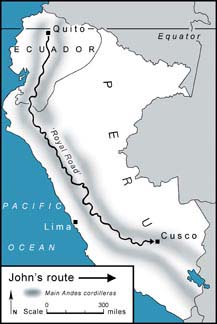
![]() Royal Road intro – First update – Previous update – Next update – Final update – Come to a talk!
Royal Road intro – First update – Previous update – Next update – Final update – Come to a talk!
After two months following the Royal Road through Ecuador, I’ve now reached northern Peru where last week I made an exciting discovery. In a remote valley, hardly known outside the area and inhabited by just a few peasant families in adobe huts, I climbed to a hilltop and saw spread out below me the remains of one of the hubs of the Inca empire.
For nearly 500 years since the Spanish conquest the city of Cajas has been abandoned and crumbling – an archaeologist’s dream. Yet when Pizarro and his conquistadors reached South America in 1532 it was a major provincial capital and a vital staging-post for the Inca’s runners on the road from Quito to Cusco.
I found it thanks to a tip-off from a Peruvian archaeologist in Lima. After long journeys by bus and lorry, I stocked up my rucksack and walked over the mountains towards the spot he’d indicated on my map. It was one of the most desperate walks I’ve ever done. Peru’s rainy season had now reached its full fury, with daily downpours turning the steep tracks into knee-deep quagmires and in some places washing whole sections of path down the mountainside. But what I found was worth the effort. Although now collapsed and covered by grass and earth, the buildings and streets of the old city were clearly visible in outline and I could well imagine the bustle and hubbub of its heyday.
Cajas was the first of the Inca settlements in the Andes to be seen by European eyes, when Hernando de Soto, one of Pizarro’s lieutenants, led an early reconnaissance party up from the Pacific coast. Among other things, this task force found in Cajas a house containing 500 ‘virgins of the sun’ – young women chosen by the Inca to devote their lives to his service. Siezed with lust and with the full approval of their commander, the soldiers raped the women at will, so beginning a period of desecration of South Americans by Europeans that was to last for almost 300 years.
I wandered round the scene
of this terrifying incident, now buried under sodden soil. One
day, I suppose, people will come to excavate and restore Cajas’s
collapsed buildings. Meanwhile I was satisfied just to have glimpsed
this impossibly remote example of Inca town planning.
